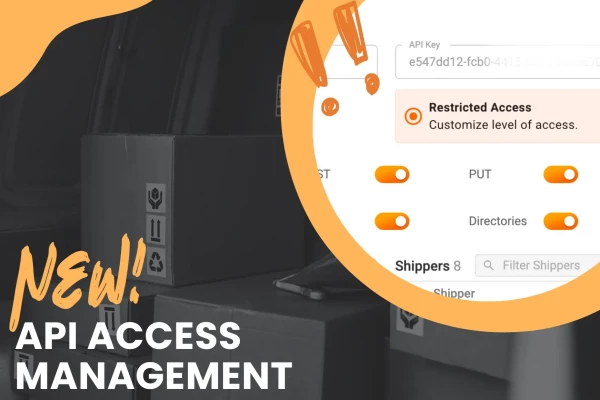Out for Delivery Status How to Explain It + Free Logistics Terms PDF

by
Alisa Cvilij
June 12, 2024
Once packages are shipped from warehouses, they have various statuses, one of which is ‘out for delivery.’
Those statuses can often be confusing, making people search for meaning.
Knowing the key terminology phrases in the delivery logistics world is very helpful in cases like these.
In fact, any frequently used terms in delivery businesses, including ‘out for delivery’ are explained in these logistics glossaries as they are created to help users understand their true meaning - you can download one now.

For recipients, the ‘out for delivery’ phrase is significant because it automatically indicates the status of the item they are waiting to come that same day.
Follow along as this blog discusses all important aspects of what out for delivery means in delivery processes.
We also share some additional information that might interest you regarding the topic. Whether your customers are confused about the status meaning or you are the customer who reads this blog, we hope you will find it useful.
Stay tuned till the end!
Table of content
- What does out for delivery mean?
- How does it work - how does a package get the status ‘out for delivery’?
- When do packages go ‘out for delivery’?
- How long does ‘out for delivery’ take?
- What causes the delay while a parcel is ‘out for delivery’- common reasons
- Does ‘out for delivery’ mean I get it today?
- The main difference between ‘out for delivery’ and ‘scheduled for delivery.’
- What do you do when your package has the ‘out for delivery’ status but does not arrive?
- Can customs clearance delay the delivery process and impact a package's ‘out for delivery’ status?
- What will happen if you miss ‘out for delivery’ day?
What does out for delivery mean?
Understanding the meaning of ‘out for delivery’ is essential for customers and those in the delivery logistics business.

When someone places an order from a merchant's interactive catalog, they receive an order confirmation. It means that the order is being processed. But it's not until the package is en route to the customer's doorstep that it gets the status 'out for delivery'.
Delivery companies, small and large, such as FedEx, Amazon, USPS, and DHL, as well as businesses that handle self-delivery and offer shipping and courier services, update a package's delivery tracking status; in this case, if they mark it as ‘out for delivery,’ that package has reached the last delivery phase.
The out-for-delivery status is the updated status of dispatchers' tracking information. It means the package is in its last phase of the delivery pipeline.
In addition, out-for-delivery is closely connected to the last-mile delivery process, which is the last step in delivery logistics.
How does it work - how does a package get the status ‘out for delivery’?
1. A package's journey starts inside the fulfillment center warehouse, and they are the first step of the supply chain.
2. When someone places an order, they receive an order confirmation. After the order is processed, it is packed and shipped.
While terminology can vary from one shipping company to another, several standard stages illustrate the sequence of it - different terminology for each stage.
3. When the warehouse staff locates the package, they mark it for shipping, and the package gets tracking information—it is in the shipped stage.
From then on, a package gets different status labels - the first label is typically marked as ‘order processing/preparing for shipment.’
4. Next, the package is handed over to the courier service and entered into the delivery tracking system. This is when recipients see their package’s tracking number.
From then on, a package can travel across several countries. Once it reaches the local delivery office close to the recipient's location, it is marked again - typically labeled as ‘arrived at hub/arrival scan.’
6. After that, the package is loaded again for delivery, labeled ‘out for delivery,’ and set to be dispatched to the recipient's location.
As you can see, the typical stages in a package delivery process are order placement < order processing <shipping the package to delivery service providers < sorting center < out for delivery < delivery confirmation.

Also, let’s not forget the technology that exists nowadays. It can be very beneficial and help with delivery management a lot. With delivery software, for example, Track-POD, you can provide customers with real-time notifications and live tracking links that give customers exact timeframes for when to expect the delivery.
When do packages go ‘out for delivery’?
- Packages get the ‘out for delivery’ status when they are ready to be dissipated to the final address - the address of the one who ordered that package.
- Before they go ‘out for delivery,’ packages are at the sorting center, where they are sorted with others based on the final destination where they should be distributed.
- Also, packages get the ‘out for delivery’ status once they reach the local post office of the delivery company hub and are ready to be distributed to the actual address of the recipient.
How long does ‘out for delivery’ take?
When a package gets out for delivery status, the pressing question arises, and that is always how long should one wait in that stage till they receive their package.
The reality is that there is no way to know how long it takes for packages to get to ‘out for delivery’ status before they are distributed to their final destination—the recipient’s address.
What causes the delay while a parcel is ‘out for delivery’- common reasons
Numerous key factors can cause a delivery delay, even for packages with the ‘out for delivery’ status. Here are some of the most prominent ones:
- Bad weather conditions.
- Bad road conditions.
- Delivery service type - some people choose express or overnight delivery for quicker shipment than the standard delivery service.
- Customs clearance delay.
- Peak holiday seasons.
Does ‘out for delivery’ mean I get it today?
In most cases, the answer is yes; however, the ‘out for delivery’ status does not always guarantee that you will get your package that day.
This is a very common question on Google Search engines. Popular SEO (search engine optimization) tools like Ahrefs show data that in the US, this inquiry is searched for around 500 times monthly.
Let’s elaborate on this a bit more.
The out-for-delivery status denotes that the last-mile delivery provider is coming to your destination. This means that the package has left the last pickup point and is headed to you as the recipient.
However, let’s not forget that there can always be reasons that will affect the delivery and cause a delay. Nobody can predict certain unpredicted events that might occur in a day.
When that happens, the latest you will get your package is the next day.
In rare cases, the delivery courier will return the package to their office, or after several failed delivery attempts, it shall be returned to the last warehouse in the delivery chain.
The main difference between ‘out for delivery’ and ‘scheduled for delivery.’
Many recipients think the terms ‘out for delivery’ and ‘scheduled for delivery’ have the same meaning.
Yet, there is a big difference between these two statuses.
- ‘Out for delivery’ indicates that a package is at the carrier and shall be delivered to the recipient as scheduled. (It refers to the attempt to be delivered that day, and it’s en route to the recipient’s destination.)
- ‘Scheduled for delivery’ means a package is planned to be delivered to the recipient (it is a stage when the delivery service staff decides on what day a package shall be delivered to the recipient’s address.
What do you do when your package has the ‘out for delivery’ status but does not arrive?
There are several things a recipient can do when their package has the out-for-delivery status yet hasn’t arrived at their doorstep.
- Check whether they’ve received an email or SMS notification from the courier.
- Check the tracking information page for the most up-to-date details on their package.
- Contact the post office to inform them that your tracking status shows ‘out for delivery,’ but the package hasn’t been delivered to you yet.

Can customs clearance delay the delivery process and impact a package's ‘out for delivery’ status?
Sometimes, it might.
If a package needs to undergo international shipping, it must pass through customs before it enters any country. The customs clearance process is when a customs agent examines the paperwork associated with a package and evaluates the tax duties that apply to imports.
In addition, these agents can ask for a customs clearance fee to handle these costs, eventually slowing the delivery process.
That said, this situation automatically prevents a package from entering its ‘out for delivery’ stage.
What will happen if you miss your scheduled ‘out for delivery’ day?
It can happen to anyone to miss the ‘out for delivery’ day. This situation is very common, and delivery agents know it, so there is no room for panic.
It can happen out of any occurrence because we all have busy lives and might not be at the address we shared as the final destination.
If, for some reason, you weren’t able to receive your package and it was labeled as ‘out for delivery,’ the delivery courier will most probably make another attempt to redeliver it - they might try to reach you a couple of times before they hold the package at the nearby delivery hub.
Usually, if couriers cannot reach the recipient, they will leave a note about rescheduling the delivery day for that particular package.
What is Track-POD & why you should try it today?
Track-POD is delivery logistics software for delivery management. It offers automation features for the scheduling processes and real-time proof of delivery.
Besides this, the software provides a live-tracking option and allows dispatchers to tailor notifications for their customers. Request a free demo or start a 7-day free trial to test the platform for yourself.
Its advanced technology software can increase delivery success rate up to 100%, and the proof of that is its features once you get ahold of them:
- Electronic proof of delivery app
- A mobile solution for real-time driver performance monitoring and delivery confirmation
- Route planning software for arranging multiple deliveries in seconds
- A QR/Barcode scanner for load control.
- GPS vehicle tracking.
- Sign-on Glass feature.
- Custom delivery notifications.
The bottom line
Remember that if your package has the ‘out for delivery’ status, it is on its way, and you’ll get it very soon, most likely on the same day.
Even though ‘out for delivery’ does not indicate when one shall get their package, it denotes that a package in the hands of the last courier service will soon reach the recipient.
Simply put, the out-for-delivery terminology in delivery logistics means that a package is en route to be dispatched to its final destination - the recipient’s address.
Last, knowing glossary logistics terminology with phrases like ‘out for delivery’ is meant not only for those who work in such businesses but also for recipients eagerly waiting for their packages to arrive.
About The Author
Alisa Cvilij
Content Marketer at Track-POD. Passionate about building meaningful and helpful content for the readers.









